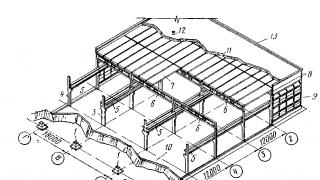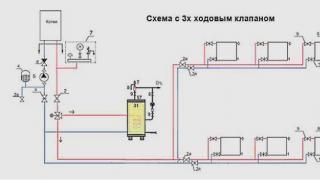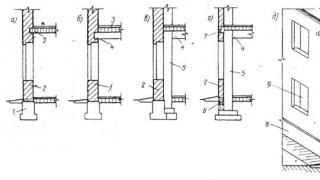All those benefits of civilization in the countryside have to create on their own.
In particular, before the homeowner is the task of organizing hot water, without which life even in the summer can hardly consider comfortable.
Let's try to figure it out in a private house.
To begin, we run throughout the range of water heaters, convenience for dividing it into several groups:
- or : These devices differ according to the principle of operation: the first warm water instantly, that is, its flow at the outlet of the heat exchanger has enough temperature; The second is equipped with a container in which the supply of water heats up gradually. Each variety has both advantages and disadvantages - it will be described below.
- Wall or outdoor: The wall variant is more convenient, as it can be placed over the sink, a tank of the toilet, a cutting table, that is, a place on the floor can be somehow used. If the outdoor option is installed, the room will seem closer. Of course, with a large mass of the water heater, you do not have to choose - such devices are made only in the outdoor performance.
- , wood: For the convenience of operation, the first place is electrical appliances, then gas and solid fuel. However, in view of the high cost of electricity, gas water heaters remain the most popular.
In addition to the listed, indirect heating boilers are also used quite often, which do not have their own heat source. The water in them heats the heat carrier of the heating system flowing through the skeleton existing inside.
Arrangement of a country house with hot water
If the house is only built and is not yet equipped with a heating system, the purchase of a separate water heater is not mandatory. You can purchase a double-circuit boiler, which connects to the heating system, and to the water supply. It works according to the following scheme: when there is no hot water consumption, the coolant circulates along the usual route:
- through the main heat exchanger of the heater and the heating system;
- when the user opens the crane, the boiler switches, so the coolant is sent to an additional heat exchanger of hot water supply (this is the second circuit).
In summer, a 2-contour boiler provides hot water flawlessly, in the winter, an important disadvantage is manifested: while the crane for hot water is opened, it does not come to the heating system. There are models that periodically warm to the heating circuit still "throw up", but then the water from the crane is poured, then a little hot, then it is more cooled that it is very uncomfortable.

Connecting an electric water heater
However, 2-contour heaters today are fairly in demand because of two important advantages:
- one combined device is cheaper than two separate;
- and at the same time takes the minimum of space.
The double-circuit boiler warms the water in the flow mode and if it has low power, the performance will surely seem insufficient. For example, in winter to heat the water to a temperature of +40 0 s in an amount of 5 - 6 l / min (approximately 0.1 l / s), namely, such consumption and temperature are needed to receive a soul, power will be required.
Q \u003d 4200 * 0.1 * (40 - 7) \u003d 13860 W \u003d 13.86 kW,
Where 4200 j / kg * 0 C is the heat capacity of water, (40 - 7) is the temperature difference. So that it was possible to enjoy hot water at least in one place, you will need a 1.5-fold boiler. For a small house, it is impractical to buy it, so instead of a 2-contour unit, it is better to purchase a heater with the possibility of connecting an indirect heating boiler.

Electric referee
It has a decent volume and, accordingly, it takes a lot of space, but it can fully supply hot water to several consumers, although for a limited time (depends on its volume). After the reserve of heated water is consumed, it will have to wait for some time until a new portion is warmed.
Boylers of indirect heating in winter are inherent in the same disadvantages as 2-contour boilers. Those who are not ready to put up with them buy individual water heaters.
Selection of heater
If possible, the overwhelming majority of homeowners sets the gas water heater.This device has a number of significant drawbacks:
- chimney is required;
- you need to get permission and call specialists for installation (independent connection is prohibited by law);
- there is a danger to poison natural gas or products of its combustion (gas carbon monoxide).
But all these difficulties of buyers are not scared, since gas is the most affordable fuel (under the condition of centralized gas supply).
From gas water heaters most often acquired flow, which are called gas speakers in everyday life. As shown above, it requires significant power to heat the water, but household gas supply networks, as a rule, may well provide it. 24-30 kW columns are not rare, but there are 40 kW units. This installation is able to "pull" a large cottage.

Wall water heater
The columns are very different, but first of all it is worth paying attention to the ignition system. There are two options:
- In the column there is a duty burner (wick).
- Gas in the main burner lights up from the spark, which is produced by batteries, household power grid or a piezoelectric, operated by the flow of water (the turbine is installed in the plumbing pipe).
It is better to give preference to the second option. At first glance, it may seem that small wick (first option) spends gas in meager quantities, in fact, the fuel consumption is increased by a third.
The columns in which the spark is produced by the flow of water, demanding to the pressure in the plumbing. If the country house is powered by the water tower, such a column is likely to work.
And only in cases where the gas supply system is not able to provide sufficient power, the gas boiler is installed.

Cumulative water heater in the bathroom
Several more expensive in operation water heaters on solid or liquid fuel. But they are extremely inconvenient in the fact that the fuel must be stored somewhere, and if it comes to firewood, then also put into the furnace. Therefore, such devices are installed only in extreme cases.
If there is no gas, but there is electricity, then instead of the wood-based, it is better to purchase an electric water heater. Values \u200b\u200bfrom him - even debt:
- chimney is not required;
- no noise;
- easily control (power varies in the widest limits);
- installation operation is fully automated;
- you do not need to bring fuel and you do not need to store;
- there is no danger of fire and household poisoning.
All these "pluses" encourage the preferred electricity of wood with coal, even though it is quite expensive.

Outdoor boiler
If the gas is most often put, then with electric water heaters, the other way around - boilers are mostly acquired. The fact is that household networks are not calculated at considerable power. Even for connecting 15 kW, with a high probability, it may be necessary to replace not only the cable, but also the transformer at the substation, which will fly away to the customer in the round sum.
However, still produced. It is impossible to get a lot of hot water from them, so they are used mainly in country houses or in urban apartments - to somehow interrupt during short-term discs of the Centralized DHW system.
With an electric runner, it makes sense to acquire a special shower and spill, which are capable of issuing a high-quality "rain" and a jet at a small consumption.
Electric "drocks" are two types:
- non-pat;
- pressure.
Non-pressure connected to the removal of water supply after the valve (crane) and are a water-based point. Pressure can crash into a plumbing, and thus supply hot water into several points of water intake.
Tanks heating naturally
With current high costs it would be foolishly dischargeing natural sources of heat.The easiest option is to install the tank on the roof, painted in black. But today such "technology" is considered obsolete.
It is much more expedient to absorb solar warm with a solar collector.
Such devices are constantly being improved, the most modern capable even in winter heat the fair amount of water to the order of +70 0 S.
Vacuum tubes and special materials that are poorly emitted in the infrared range are used. In summer, excess heat can be used to heat water in the pool.
In solar collectors, very durable lighting materials are used, so hail is not terrible to such installations.
In addition to solar radiation, so-called low-precision heat sources are used. In this capacity, it can act as a soil or water with a temperature of the medium +7 - +12 degrees, or even frosty air. Thermal energy from such a source "rolls out" with a thermal pump similar to the one that works in the refrigerator and air conditioner. Of course, it takes electricity to work for its work, but it gives it to 1.5 - 3 times more than the electricity spends.
The principle of operation of the heat pump consists in altered compression and expansion of gas, which, accordingly, heats up (gives heat to heat heating) and cools (takes heat from the low-precision source).



